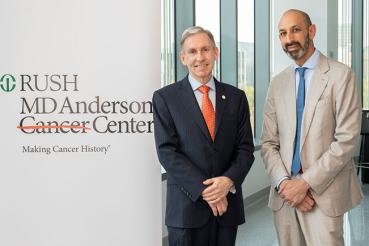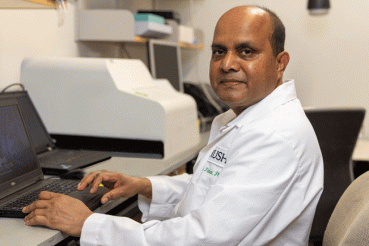Podcast transcript
What are the current standard therapies at RUSH for treating non-small cell lung cancer?
At RUSH, the vast majority of our patients are presented at our multidisciplinary case conference, and many are actually seen in the multidisciplinary clinic and have in one place for patients to get one opinion that includes opinions from thoracic surgery, radiation oncology, interventional pulmonology and even palliative care. Our philosophy is to try to take an aggressive approach when that makes sense for patients, and really individualize a patient treatment plan to be implemented, either at RUSH or in collaboration with treating physicians outside.
At RUSH, we've been working on augmenting our technology and have now robot-assisted navigational bronchoscopy and endoscopy. We also have highly specific radiation planning machines, as we've recently moved into our new Rubschlager Cancer Center Building. We use state-of-the-art, SBRT, radiation planning, navigational bronchoscopy and endoscopy with both robot and ultrasound machines.
I want to go a little deeper here and ask you about patients with non-small cell lung cancer, and that somewhere between 10 and 14 months, those patients will develop resistance to EGFR TKI treatment. I'd like to talk with you first about the ways you're looking at augmenting EGFR TKI treatment in newly diagnosed patients.
I think that many patients, when they hear they have an EG for activating gene mutation, are happy to know that the first therapy is a pill. But unfortunately, the cancer is still expected to shorten their life and resistance develops. One strategy we're participating in is a trial through the Hoosier Cancer Research Network that adds VEGF receptor two antibody therapy with Ramucirumab in addition to Osimertinib. So it is a randomized trial with two-thirds of patients being randomized to get the anti-VEGF targeting agent.
There also have been strategies to add chemotherapy to frontline Osimertinib for patients with EGFR, and, at the end of the day, that strategy will probably provide some benefit as we've seen from recent trials out of Japan and India. But the question remains how much the benefit and if a patient will deem it worth it to do for the extra toxicity that they'll experience, and the extra trips to the medical center to get this chemotherapy. Hopefully, the answer for the flower trial will sort that out, but I think we're a couple of years from getting a more definitive answer.
Talk a little bit about the work you're doing with biomarker identification, MRA sequencing.
We recently began a collaboration with Tempus to use data we have from patients who have mRNA sequencing and EGFR activating gene mutations. We presented some preliminary data showing volcano plots with different genes that seem to be activated in these patient populations, and now we're delving deeper to look at our own institutional data, finding out how is this disease different in patients that get it later in life, versus some of these patients that get a diagnosis early in their 40s and 50s, even 60s. So those are some exciting things we're doing internally with our dataset.
We also are collaborating with a network that hopefully will allow us to get big answers to questions like mRNA expression and progression on Osimertinib therapy through some collaborations we've recently joined, also through Tempus. I'm particularly excited about studying cancer cachexia in patients with driver mutations. We all know that weight loss and skeletal muscle loss is a common feature in patients with lung cancer, especially as they move further on in their journey. But this concept is not well-studied in patients with driver mutations and could be another target we could have to improve quality of life for these patients in the future.
One aspect of our research in patients with driver mutations that I'm particularly excited about is looking at skeletal muscle wasting in patients with driver mutations. We all know that cancer cachexia has a bad prognosis and increased toxicities. We presented some data suggesting that weight gain on treatment, including standard chemotherapies, is associated with better outcomes, but this is an understudied area in patients with driving mutations. And also, I think we're still learning a lot about patients who are receiving immune checkpoint inhibitors. Cancer cachexia has been a research interest of our lung cancer working group for many years. We're excited to learn more as we start to incorporate newer information like protein expression data in addition to what we can learn from a CT scan and measuring a patient's weight in clinic.
How novel is this focus that you're with this particular research?
I think it's fairly novel. I think it's fairly understudied and I think the EGFR stuff is fairly novel too. There are publications looking at co-expressed DNA mutations, but not a lot with RNA and we've been using Tempus so long, we have a large amount of patients who have tumors sequenced with EGFR that we can work with. So I think that that's pretty novel too.
I want to ask you about the ADAURA trial. It's a phase three clinical trial that showed that just in March of 2023, Osimertinib produced a statistically significant and clinically meaningful improvement in overall survival for patients with early-stage EGFR mutated non-small cell lung cancer after complete tumor resection. Can you talk a little bit about the promise of these early results?
I was chosen to be the National PI for the ADAURA trial and was quite excited about the press release you just referred to showing an overall survival benefit using postoperative Osimertinib compared with placebo in patients with resected EGFR mutated lung cancer. There was no doubt that this medicine delayed cancer progression and the PFS curves, or pressure-free survival curves, were quite separate. and I think everyone was hoping that this could lead to an overall survival benefit. But nobody wanted to subject a patient to three years of side effects—albeit low grade, but still side effects that affect quality of life—if we didn't have a signal that it was actually helping them live longer.
So that was very, very exciting news and our next steps are opening up a similarly designed trial, but in even smaller EGFR positive cancers that have been resected. So we're participating in the ADAURA2 trial, which is for patients with even smaller resected tumors to see if we can also see a similar benefit in this patient population.
As part of our project with RNA sequencing data, we do have plans to look for protein expression differences in patients who have tumors that presented as an earlier stage versus a later stage, and we hope that this could better inform which patients may be more likely to get a benefit with these postoperative drugs down the road and tumor development and could even aid in lung cancer screening in the future. As many patients with EGFR, although not all, have a relatively lighter smoking history, and we don't know which patients should be screened for lung cancer. Right now, we are limited to those that really meet eligibility for the lung cancer screening trials that have been conducted.
Lastly, I want to talk with you about your work with Tempus and the research that's ongoing in that space. Could you elaborate about that relationship that RUSH and Tempus have had for I think quite a long time now?
At RUSH, we have had a nice partnership with Tempus for a number of years now, and we have over 2,000 lung cancer tumors sequenced with Tempus, including DNA and many with RNA sequencing profiles. It's an enormous dataset and there are so many questions that we can answer, including RNA tumor expression and cancer cachexia, RNA tumor expression and benefit on therapies for patients with driver mutations and benefits on patients who are receiving immune checkpoint inhibition. So we're particularly grateful that we have this database and our collaboration has allowed us to get our patients' data back in a meaningful way where we can do some of these analyses.
I would say that the sheer number of patients that we have these genetic profiles on positions us to really ask meaningful questions and get results. Rather than having 30, 40, 50 patients that we're trying to detect these complex signals with many, many data points in RNA and DNA sequencing, we have the numbers where we can generate a hypothesis and validate that with expression profiles from other institutions or even potentially that Tempus may have in their database.
The strength of our Tempus partnership is that we have at our fingertips an enormous amount of data, and when generating hypotheses for tumor resistance and cancer cachexia, it is really helpful to have the big numbers as we try to make sense out of the multitude of gene rearrangements, amplifications and RNA sequencing changes that we have for patients with lung cancer. Our hope is that our analyses of our patients could yield meaningful hypotheses about potential synergistic treatment strategies and even how to maximize benefit with immunotherapy or reduce the burden of cancer cachexia for our lung cancer patients.




